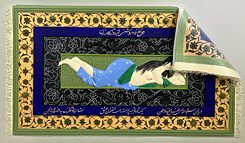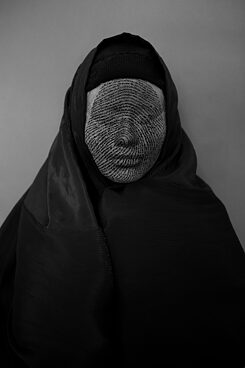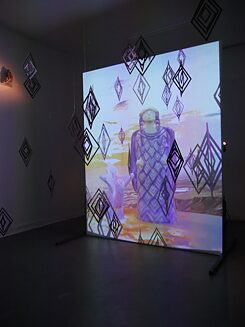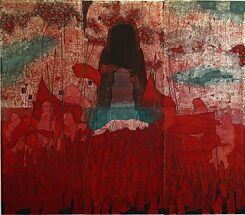with Rada Akbar, Leila Mousavi and Mohsin Taasha, curated by Sara Nabil
The exhibition
Invisible Power - Striving for Femininity and Identity curated by Sara Nabil aims to unveil the strength, identity, and resilience of marginalized groups who have been historically discriminated in Afghanistan. Above all, it celebrates the power of femininity by showcasing different perspectives and narratives on the challenges Afghan women have encountered throughout the country’s history. Sara Nabil intends to encourage introspection and dialogue, shedding light on the struggles and sheer willpower of these women in the face of historical adversity and ongoing conflict.
Programme
Fri., 08.12.2023, 6pm: Exhibition Opening at ACUD Galerie
Sun., 10.12.2023, 2pm: Artist Talk with Rada Akbar, Leila Mousavi, Mohsin Taasha (digitally),
moderated by Sara Nabil (ENG)
Sat., 16.12.2023: Curatorial Tour with Sara Nabil, 3pm ENG, 4.30pm DARI
Sun., 14.01.2024: Curatorial Tour with Sara Nabil, 3pm ENG, 4.30pm DARI
Opening Hours
Thurs. – Sun., 3:00 – 7:00pm
Closing time: 23.12.2023 – 03.01.2024
In the digital exhibition flyer you can find further information about the curatorial concept, the art works and the artists:
Artists
 © Rada Akbar
Rada Akbar is a conceptual artist. In her work, she denounces the oppression borne by the women in her country, upholds their rights, and draws attention to their role in society and history. In Afghanistan and in her recent exile in Paris, Rada Akbar has used art to denounce this reality and to testify to the presence of women who have contributed to the history of their country. With photography, performance, and the plastic or textile art, frequently recovering traditional techniques, Akbar gives expression to the pain of Afghan women as she presents their strength and courage in different forms which make them visible to the rest of the world. Recently, she has been working to recover the tradition of the Persian miniature combined with the art of rug making as a way of portraying the history of Afghan women.
© Rada Akbar
Rada Akbar is a conceptual artist. In her work, she denounces the oppression borne by the women in her country, upholds their rights, and draws attention to their role in society and history. In Afghanistan and in her recent exile in Paris, Rada Akbar has used art to denounce this reality and to testify to the presence of women who have contributed to the history of their country. With photography, performance, and the plastic or textile art, frequently recovering traditional techniques, Akbar gives expression to the pain of Afghan women as she presents their strength and courage in different forms which make them visible to the rest of the world. Recently, she has been working to recover the tradition of the Persian miniature combined with the art of rug making as a way of portraying the history of Afghan women.
 © Leila Mousavi
Leila Mousavi is an Afghan artist based in Hamburg. She uses 3D simulation, video, sound, sculpture, and digital fabrication to recreate myth and history. Through archival practices and storytelling, her work interweaves intricate counternarratives that challenge the enduring influence of colonialism and patriarchy.
© Leila Mousavi
Leila Mousavi is an Afghan artist based in Hamburg. She uses 3D simulation, video, sound, sculpture, and digital fabrication to recreate myth and history. Through archival practices and storytelling, her work interweaves intricate counternarratives that challenge the enduring influence of colonialism and patriarchy.
 © Mohsin Taasha
Mohsin Taasha is a visual artist from Afghanistan, based in Nice, France. His fundamental study and practice of the arts began during his high school years in 2008. He obtained a BFA Degree from BNU-Beacon House National University of Lahore, Pakistan, in 2017. Although most of Taasha’s artworks are paintings or drawings, he includes other mediums such as video art and installations as part of his artistic experimentation and creation. Mohsin identifies himself as a Hazara, an ethnic group in Afghanistan, which has faced persecution throughout the history of the country. Their ethnic identity faced them with severe challenges and caused catastrophic consequences such as systematic genocides. As Mohsin says: “The Hazara ethnic is one of the most persecuted group of people on earth.”
© Mohsin Taasha
Mohsin Taasha is a visual artist from Afghanistan, based in Nice, France. His fundamental study and practice of the arts began during his high school years in 2008. He obtained a BFA Degree from BNU-Beacon House National University of Lahore, Pakistan, in 2017. Although most of Taasha’s artworks are paintings or drawings, he includes other mediums such as video art and installations as part of his artistic experimentation and creation. Mohsin identifies himself as a Hazara, an ethnic group in Afghanistan, which has faced persecution throughout the history of the country. Their ethnic identity faced them with severe challenges and caused catastrophic consequences such as systematic genocides. As Mohsin says: “The Hazara ethnic is one of the most persecuted group of people on earth.”
Curation
 © Sara Nabil
Sara Nabil, artist and human rights activist
© Sara Nabil
Sara Nabil, artist and human rights activist
"Throughout history, the identity of women and their role in society have been influenced by political and social factors. Patriarchy, religion, colonialism, and political systems have consistently exploited femininity, often stripping women of their identity and relegating them to a secondary gender role. Despite this, women have continuously fought against these forces throughout different historical periods, striving for the recognition of their female identity and their pivotal role in a patriarchal world.
The concept of Invisible Power – Striving for Feminity and Identity aims to bring to light the strength, identity and resilience of marginalized groups who have been historically discriminated against due to various societal factors that obscured their influential roles. In the context of Afghanistan's history, women in Balkh, the former capital of the Bactria Empire, once held positions akin to revered goddesses, worthy of worship and possessing divine status. However, social, political, religious shifts, as well as the subsequent impact of colonialism have resulted in women losing their divine status and to endure centuries of subjugation instead, to the extent that they are relegated to the confines of their homes in current times.
Today, Afghan women face complete marginalization, lacking even the most basic human rights. These restrictions stem solely from their gender and identity as women. Under the rule of Taliban, there is no room for the acceptance of this identity. Afghan women, echoing the struggles of the past, continue their fight to reclaim their lost identity and challenge the most misogynistic forces in history, advocating for bread, work, and freedom to regain their rightful place in society. This exhibition celebrates the power of femininity, identity, and resilience, showcasing diverse perspectives and narratives. It aims to encourage
introspection and dialogue on these themes, shedding light on the struggles and strengths of women in the face of historical adversity and ongoing challenges." - Sara Nabil
Art work description
 © Rada Akbar
The Goddesses of Hope, Rada Akbar
© Rada Akbar
The Goddesses of Hope, Rada Akbar
"This piece is a contemporary reflection of the realities faced by Afghan women, inspired by a 1590s miniature painting from Herat. Traditional motifs are transformed into contemporary symbols, representing the challenges and struggles confronting Afghan women today. The substitution of a garden of roses with thorns, and roses with blood drops and dried opium flowers symbolises a shift from beauty to pain and suffering. The inclusion of a hidden snake, represented in black, signifies the dark and regressive situation women face in Afghanistan. Replacing the original poetry with a contemporary poem written by Mahtab Sahel amplifies the voice of Afghan women and showcases their resilience and desire for change. The image of a sculpted carpet being folded to hide the woman's face symbolises the Taliban's efforts to erase women and their cultural heritage, representing the suppression of women's voices and restrictions on their freedom."
 © Rada Akbar
Invisible Captivity, Rada Akbar
© Rada Akbar
Invisible Captivity, Rada Akbar
"In 2013, Invisible Captivity was created, a mixed photo and painting project shedding light on the cultural and religious forces that shape women's lives and identities, particularly in Afghanistan. Through the use of fingerprint-like patterns, it highlights the verses from religious texts and Hadiths which are often used to justify the violation of women's rights. This work is a powerful reflection of the agency of women and has been a defining moment in my life as an artist."
 © Nima Latifi
Thousands of Untold Stories, Leila Mousavi
© Nima Latifi
Thousands of Untold Stories, Leila Mousavi
"In Thousands of Untold Stories, a part of the Lost Goddesses project, I have tried to combine the tales of 40 girls and lesser-known goddesses of Bakhtar in order to reconstruct and redefine narratives that exemplify the power and significance of women's roles across different eras of Afghanistan. These are the women who have deliberately been marginalized and rendered invisible. I utilized diverse artistic mediums including sculpture, video, sound, and poetry to bring visibility to these women. Many women with various backgrounds participated in this project."
 The Rebirth of the Reds, Mohsin Taasha
REBIRTH OF THE REDS, Mohsin Taasha
The Rebirth of the Reds, Mohsin Taasha
REBIRTH OF THE REDS, Mohsin Taasha
"The inspiration for this series came in 2016 after the horrific suicide bombings that targeted the largest rally in Afghanistan’s history in Dehmazang Square, Kabul, leaving around 400 people killed and injured. The rally was organized by thousands of Hazara activists of the Jonbish Roshnai (or ‘the Enlightenment Movement of Afghanistan’), who sought social justice and equal distribution of national resources through a series of civic protests on the streets of the country.
Many of my intellectual friends were killed or injured in these terrorist attacks and this horrible event left incurable wounds on my soul. After that, I saw everything in the colour red. Red, which once stood for passion, for love, emotion, strength, power and courage changed its meaning for me into a sign of danger and alarm once I saw the blood of my friends shed on the streets of Kabul. Thus, the meaning of this colour was literally and emotionally reborn in my mind and erupted through my new artworks after 2016. The REBIRTH OF THE REDS is a multi-medium series, which includes paintings, video art and a live performance, and I was able to create more than 40 different sized paintings in four parts that contain various narratives."
The painting series in four parts narrates the history and culture of the Hazara people, the genocide of the Hazara people, Afghanistan and its relations with the world:
Back